| |
|
Woodland and Mississippian TRADITION
(see Woodland and Mississippian
VESSEL FORMS & TECHNIQUES
below)
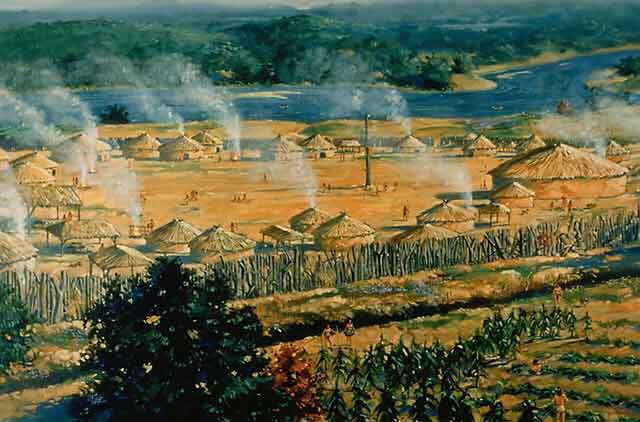 |
| |
|
|
|
|
THE WOODLAND
TRADITION
The Woodland Tradition is
generally distinguished from the earlier Archaic Tradition by the
construction of burial mounds, the advent of rudimentary cultivation,
and by the presence of cord and fabric marked pottery types. This
began around 700 BCE and reached its climax about 100 BCE. Remnants of
the Woodland tradition lasted into the modern era.
The Woodland Tradition is
divided into two periods. The first, Burial Mound I, dates from
700-300 BCE, and is best represented by the Adena culture of the Ohio
Valley. Sites are marked by burial mounds and/or earthworks. A cult of
the dead seems to have been a major part of Adena life. Away from the
burial centers, small villages of three to five houses prevailed.
Ceramics were simple in form, with cord or fabric marking and
occasionally incised decoration.
The second period, Burial
Mound II, spanned from around 300 BCE to 700 CE. This period saw the
rise of the Hopewell culture, which was little more than an
elaboration of the earlier Adena culture, and the dividing line
between them is not very clear. Earthworks were larger and more
complex, burial mounds were larger, and ceramics forms more
sophisticated and varied. Specialty vessels were developed
specifically for ceremonial use. Hopewell culture was carried
throughout the Upper Mississippi and Missouri valleys. |
|
http://www.beloit.edu/~museum/logan/mississippian/introduction/woodland.htm |
|
|
|
|
|
Mississippian Cultures |
|
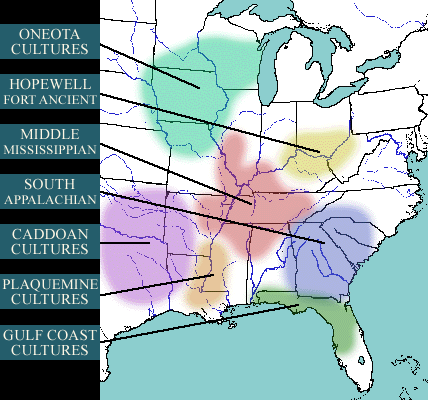 |
|
|
|
|
|
THE MISSISSIPPIAN
TRADITION
The
Hopewell culture began to fade near the end of the Burial Mound II
period. Around 700 CE a new tradition known as the Mississippian was
forming in the area of northeastern Arkansas and southeastern
Missouri. For the purposes of this exhibition, this region will be
referred to as the "core area". There were substantial differences
between Mississippian sites and their Woodland predecessors. Sites
were marked by flat-topped mounds upon which temples and important
buildings were constructed. As such, the Mississippian Tradition is
divided into Temple Mound I and Temple Mound II periods. In contrast
to the Hopewell sites, burial mounds became far less significant.
Agriculture intensified considerably with the introduction of better
strains of maize, which resulted in a far more sedentary lifestyle.
New vessel forms arose along with new types of decoration. Shell
tempering became the norm. Many of these characteristic features
clearly indicate Mesoamerican influence. The relatively smooth and
slow transition from Woodland to Mississippian traditions indicates
that this influence was not direct, but absorbed gradually over time.
The Mississippian tradition is best represented by the site at
Cahokia, in southern Illinois. The Temple Mound I phase is not well
understood, but it appears to have been the continuation of a trend
towards nucleation into large centers, but now these centers took on
a form more like their Mesoamerican counterparts. From Cahokia other
sites were "colonized" in outlying areas, such as Aztalan in
Wisconsin, Obion in western Tennessee and Hiwassee Island in eastern
Tennessee, and Macon, Georgia. Contemporary developments were
occurring
in the Lower Mississippi Valley, with the Coles Creek cultures of
Louisiana and Mississippi. These were similar to the Cahokia types,
and exerted influences eastward into Florida and Georgia and westward
up into the Caddoan regions along the Red River.
The Mississippian Tradition reached its zenith between 1200 and
1500 CE. Areas which had at one time been a mix of Mississippian and
Woodland traditions now became predominantly Mississippian, yet they
retained the differentiation created by their varying Woodland
heritages. Cahokia continued to expand, and larger sites proliferated
in the core area of southeastern Missouri and north- eastern Arkansas.
In the Ohio Valley, Hopewell lifestyles gave way to a more sedentary,
Fort Ancient variant of the Mississippian. The influence of
Mississippian culture can also be found to the northwest, in the
Oneota culture which fused earlier Woodland traditions with the new
imports. Ceramics forms continued to expand and now included far more
sophisticated forms, such as effigy vessels, and various types of
painted decoration.
The development of the Woodland and Mississippian Traditions can
best be traced in the evolution of pottery forms through time. By
measuring changes in vessel forms and decorative techniques, it is
possible to understand just how the peoples of each region combined
the elements of these two traditions into their own local variants. |
|
http://www.beloit.edu/~museum/logan/mississippian/introduction/mississippian.htm |
|
|
|
|
|
|
Excellent information
from the Logan Museum
of Anthropology on line from
Beloit, Wisconsin |
|
All text and images are used courtesy
of the Logan Museum of Anthropology, Beloit College
(
http://www.beloit.edu/~museum//logan/index.html).
All objects illustrated are in the permanent collection of the Logan
Museum. |
|
|
|
Woodland and Mississippian VESSEL
FORMS
|
   |
Ceramic production was a
relatively new concept during the Woodland Period, and there was
not a tremendous variety of vessel forms. In fact, bowls were
often carved from soapstone rather than being ceramic, and those
which were ceramic were of the simplest types.
|
  |
Jars were by far the
most common vessel form during the early period. Some had flat
bottoms or were provided with four short legs. The most common
type, however, was the "conoidal-based" pot, seen at left. This
form is an indicator of the Woodland Period, as later it was
rather uncommon. |
  
|
A far greater variety of vessel forms existed during the
Mississippian Period. Bowls were made from clay rather than stone.
Forms ranged from wide, shallow types to globular bowls with
slightly incurving rims. The rims of most bowls were either
beveled or provided with simple filleted decoration. Some bowls
also had flared rims which were decorated in some manner along the
exterior of the rim.
|
  |
A jar is distinguished
from a globular bowl in that its opening is more constricted, and
may also have a short neck. The globular jar seems to have been
the most prevalent type, generally provided with a short rim or
neck. Lugs, which are loops added to the rim through which a cord
might be run to suspend the pot, were common features. Jars with
necks tend not to have lugs, as they could usually be grasped by
the neck. The deep jar, similar to the conoidal-based jars of the
Woodland Period, remained, but now usually had the characteristic
rim and slightly flattened bottom.
|
  |
Bottles differ from jars
in that they have much longer and narrower necks. They were used
to store water, and were most often utilitarian and undecorated.
Those which were used for ceremonial purposes, however, were
provided with painted or incised decoration.
|
  |
The hooded "bottle" is
really more like a globular jar, but the very constricted opening,
provided in the back of the "head" of the vessel, places it in the
bottle category. Hooded bottles are invariably small - about 4" to
7" tall - and are nearly always in the form of some animal or
human.
|
 
 |
One of the unique
features of Mississippian pottery, as compared with earlier
Woodland types, is the prevalence of effigy vessels, that is,
pottery which is made in the form of an animal or human. Common
subjects are those found in the everyday life of river peoples -
fish, beaver, opossum, shells and wildcats.
Humans effigies were also very popular, often only distinguishable
by a face. The most peculiar effigy type is the hunchback. This
deformity must have been fairly common, and those afflicted were
often revered as shamans. |
| |
The tremendous variety of vessel forms was matched by an equal
variety of techniques employed in their decoration...
|
|
|
http://www.beloit.edu/~museum/logan/mississippian/introduction/vesseltypes.htm |
|
|
|
|
DECORATIVE
TECHNIQUES
|
   |
Mississippian vessels
were generally constructed using the coiling method. Hand-rolled
coils of clay were built up from the base to create the general
form of the vessel. The vessel was then smoothed on both the
interior and exterior. Often additional texture or decoration were
added to the exterior before firing. Once fired, the pot might be
further polished using a clay polisher like those depicted at
left. I have seen them referred to as "trowels" and "polishers",
indicating that scholars are unclear as to whether they were used
to help fuse together the coils during construction, to brighten
up the finish of a fired pot, or perhaps both.
|
  |
All ceramic vessels are
created with clay to which some binding agent, called temper, has
been added. This gives the vessel far greater strength. The
earliest vessels in the Southeast were tempered with fibers of
grass or roots. By the Woodland Period, mineral tempers became the
norm. Grit, crushed rock, sand or ground ceramic sherds were the
most common types.
|
 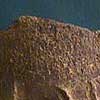 |
Fabric Marked vessels
have a rough surface whose texture resembles that of a textile.
This is because the vessels were smoothed before firing with a
wooden paddle wrapped in fabric. Once smoothed, the paddle was
pressed against the vessel to provide the characteristic texture.
|
 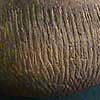 |
Cord Marked vessels were
prepared in the same manner as Fabric Marked pottery, except that
the wooden paddle was wrapped with cord rather than fabric. This
resulted in a finish which resembled incising, except that the
lines are usually curved and very closely spaced, and their ends
nearly always overlap.
|
  |
Sometimes paddles were
carved with some sort of curvilinear pattern, which created a
surface which was far more decorative. This decorative technique
was particularly popular in the Swift Creek area of central
Georgia. I suspect these textured types of "decoration" were in
fact an effort to increase the handleability of the vessel, as
they usually occur on pots without handles.
|
  |
Rocker Stamped vessels
have patterns created by rolling curved "rocker stamps" over the
surface of the vessel. Rocker Stamps usually create the appearance
of regularized pinpricked decoration, and are often applied in
linear or curvilinear patterns.
|
  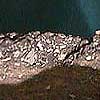 |
One of the major
distinguishing features of the ceramics of most Mississippian
cultures was the wholesale adoption of shell tempering. The use of
crushed shells apparently had a number of advantages over mineral
tempers. Chemical reactions created during the firing process made
the vessels even stronger than before. The shell also aided in
heat transfer, making cooking vessels far more functional. Shell
temper is often visible on the exterior, making it an easy
indicator.
|
 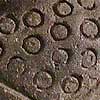 |
Punctated designs are
those which were punched into the surface using some sort of sharp
tool or even the fingernail. Usually the indentations are not very
deep and are either conical indicating an awl-like tool, or
elongated and rectangular indicating a narrow flat tool. The
example at left is somewhat unusual in this regard.
|
  |
Incised decoration was
created by drawing linear or curvilinear patterns on the unfired
clay. Incised decoration is distinguishable from engraved
decoration by the buildup of excess material along the edges of
the incised lines. This is visible in the example at left.
|
 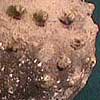 |
The use of noding was
limited to a fairly small area in the core region of Mississippian
culture. Nodes are small balls of clay which have been added to
the surface of the smoothed pot. Two varieties are found, the
first having nodes situated in an allover pattern, the second
having one or two distinct rows of nodes placed near the rim.
|
 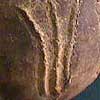 |
When patterns were
created by adding raised designs in clay to the surface of a
smoothed vessel, it is termed "appliqué". Noding might be thought
of as a form of appliqué, but the typical form creates some
variety of linear patterning. Zigzag is common, especially along
rims, and beaded rims are also considered to be of this type.
|
 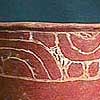 |
Engraved decoration was
created by scratching away at the surface of a vessel which had
already been fired, revealing the natural color of the clay below.
This must be done with a very sharp tool, and as such, solid areas
of engraved design always show telltale scratch marks created by
the tool, and are often not even completely cleared of the surface
color, as seen at left.
|
  |
All of the previously
mentioned decorative techniques have been "plastic", meaning that
they were modifications to the actual clay of the vessel. Painting
is a surface decoration, and was usually added to the vessel after
it had dried, but before it was fired. Red and white were the most
popular colors, black being a late addition.
|
  |
Negative painting
involved painting the majority of the vessel some background
color, usually black, but leaving the linear design unpainted.
After the vessel was fired, the natural clay color remained light,
showing through as the pattern color. This was often enhanced with
the addition of a third color, usually red, to complete the
design.
|
| |
With this background in
the traditions of the early peoples of eastern North America and
their techniques ceramic production behind us, we can now better
appreciate the artifacts themselves... |
http://www.beloit.edu/~museum/logan/mississippian/introduction/techniques.htm |
|
|
|
| |
|
 ClayHound Web
- Woodland - Mississippian
Pottery
ClayHound Web
- Woodland - Mississippian
Pottery






















